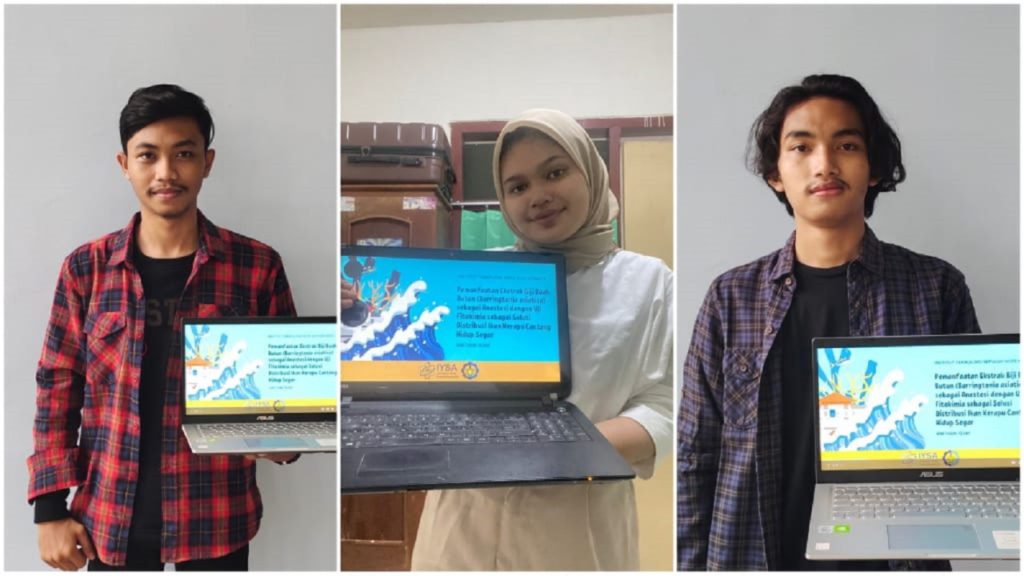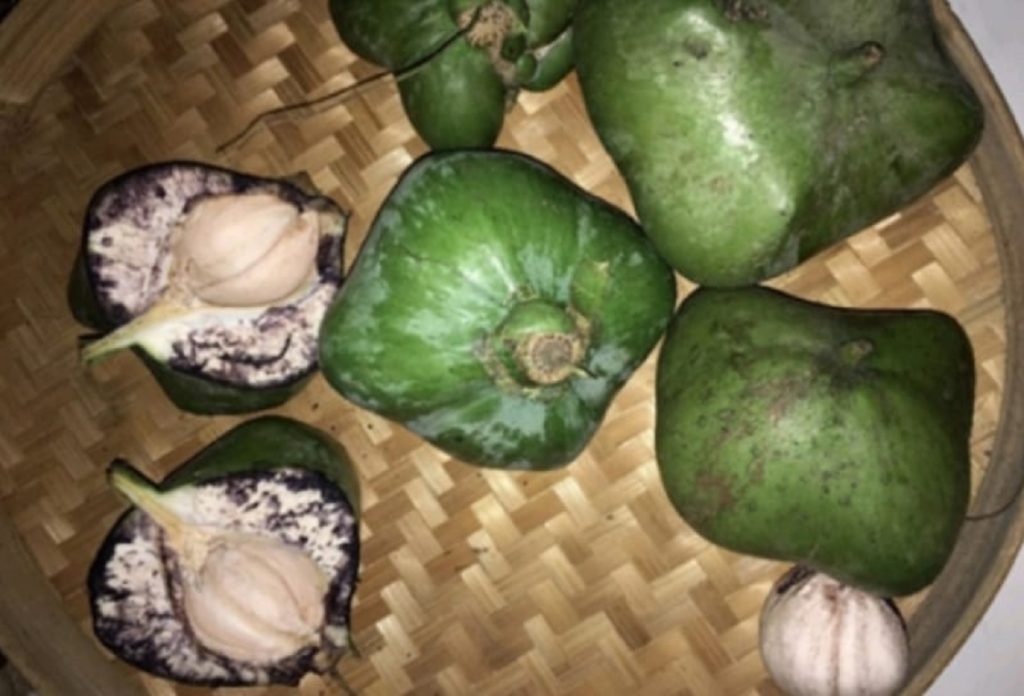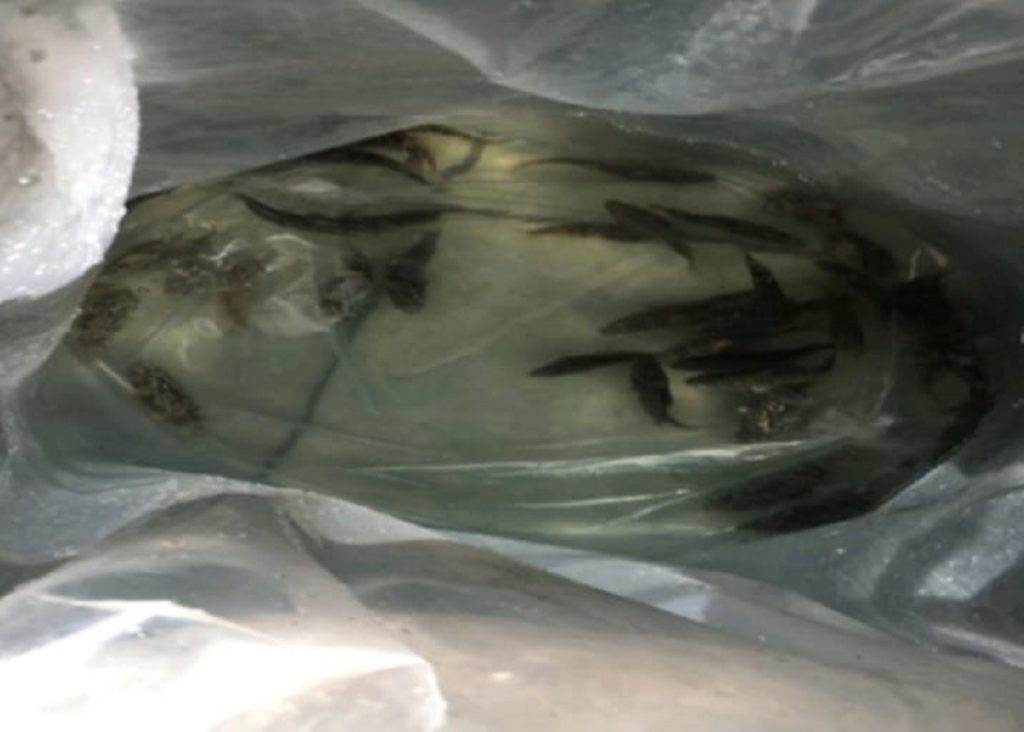ITS Students Research Butun Fruit as Natural Anesthesia for Groupers

(from left to right) Ramadhita Putra Purnomo, Dwi Mayasari, M Sahar Mahdan Ardli as team members from the ITS Chemical Engineering Department who researched Butun fruit for fish anesthesia
Campus ITS, ITS News – It started with a dream about Indonesian fishermen so that they can continue to realize the Sustainable Development Goals (SDGs) in terms of revitalizing fisheries, cutting distribution channels, and improving fish quality. For this reason, a team of students from the Institut Teknologi Sepuluh Nopember (ITS) initiated research by testing the effectiveness of butun fruit seeds in quantity and quality (phytochemical test) on the survival rate of cantang grouper.
They are students from the ITS Chemical Engineering Department batch 2021. Consisted of Ramadhita Putra Purnomo, Dwi Mayasari, and M Sahar Mahdan Ardli who succeeded in expressing their ideas through a paper entitled Utilization of Butun Fruit Seed Extract (Barringtonia Asiatica) as Anesthesia with Phytochemical Tests as Solutions Distribution of Fresh Live Cantang Grouper.
As the team leader, Ramadhita Putra Purnomo said that this research was motivated by the fact that there are still many fishermen who maintain the freshness of fish by freezing. This has a negative impact because it can reduce the quality of fish physically, chemically, and biologically. “Therefore, innovative solutions are needed to overcome the problem of fishery distribution by optimizing the potential of Indonesia’s natural resources, one of which is anesthesia with butun fruit,” he explained.

Analysis of the condition of the butun fruit which will be targeted as the object of anesthesia research on the survival rate of cantang grouper
Based on the research literature, the anesthetic properties are obtained from the saponin compounds contained in the butun fruit. Therefore, this study also presents data and facts regarding the effects of anesthesia through a series of scientific methods. Not only that, this research was made by loading the phytochemical test of the saponin content in the butun fruit seed extract and the trial run test on the cantang grouper.
Furthermore, phytochemical tests were carried out using a hydrochloric acid solution. Hydrochloric acid was reacted with the extract of butun fruit seeds which was then shaken for 10 seconds. The shaking results show that the solution is foamy. Thus, the phytochemical tests carried out resulted in the conclusion that the butun fruit seeds contained saponins.
Foam can be formed because saponins have properties that can lower the surface tension of water. Foam is here referred to as a relatively stable structure consisting of an air pocket encased in a thin layer of liquid. “So that the gas dispersion in the liquid is stabilized by a surface tension reducing agent, in this case, the saponin molecules,” he explained.
After going through various research processes, the young man who is familiarly called Rama concluded that Barringtonia Asiatica seed extract has great potential as an anesthetic with saponin secondary metabolites as evidenced by quantitative and quality measurements through phytochemical tests. The best result is stunning fish with a concentration of 15 mg/L which can be used for dry chain transportation of cantang grouper for no more than 8 hours with a survival rate of 100 percent.
Barringtonia Asiatica or butun seed extract during the anesthetic process also resulted in a decrease in fish response and slowed operculum movement, so it would reduce the respiration rate of fish which would interfere with metabolic processes. “The decrease in metabolism makes it difficult for fish to respond and there will be a decrease in brain work in fish,” said Rama.

Condition of cantang grouper after being given anesthesia from butun fruit extraction
When asked about the SDGs strategy from the results of this research, this student guided by Prof. Setiyo Gunawan ST Ph.D. admitted to using three elements of the triple helix and the principle of reciprocity which includes academics (universities and research and development institutions), government (government), and sector actors. business. “With this, the innovation of fish anesthesia from butun fruit seed extract can be widely implemented,” he said optimistically.
Academics can become centers of innovation development with the guidance of experts in them. The government itself can provide active support through appreciation, space, opportunities, and funds for research projects. Business actors in the triple helix can be the center of the development of innovation in industrial projects, in this case, is a business.
Based on this research, the ITS team has also won third place in the National Scientific Writing Competition (LKTIN) organized by the Indonesian Young Scientist Association (IYSA), some time ago. In this event, this team managed to beat hundreds of teams from various universities in Indonesia. “This is an extraordinary achievement for our work,” he said proudly.
Closing the conversation, Rama hopes that the results of his team’s research will not only help other researchers but also fishermen and industry. It is hoped that the selling value of live fish is more expensive than dead fish, especially the selling value of cantang grouper as the largest export commodity in Indonesia. “Therefore, automatically the economy and quality of life of Indonesian fishermen will also improve,” he said hopefully. (ITS Public Relation)
Reporter: Fauzan Fakhrizal Azmi
Related News
-
Facilitating Creativity of Students, ITS Information Systems Department Presents CCWS
ITS Department of Information Systems students conduct a discussion in one of the available spaces in the ITS Digital
April 14, 2022 14:04 -
ITS Explores Electrification Cooperation with PT Vale Indonesia
ITS Campus, ITS News — Following up on the Memorandum of Understanding (MoU) with PT Vale Indonesia, Institut Teknologi
April 14, 2022 14:04 -
ITS Reaches Top 7 BRIN Collaborators with 309 Scientific Publications
ITS Campus, ITS News — Institut Teknologi Sepuluh Nopember (ITS) continues demonstrating its commitment to strengthening collaboration in research
April 14, 2022 14:04 -
The Only One from Indonesia, ITS Student Becomes Erasmus+ Scholarship Awardee
ITS Campus, ITS News — Civitas academica of Institut Teknologi Sepuluh Nopember (ITS) has once again contributed to making
April 14, 2022 14:04
